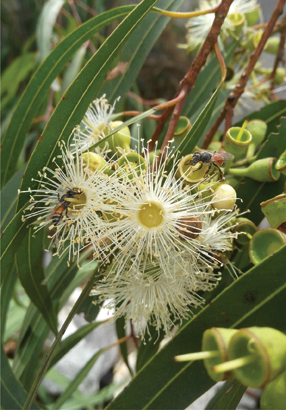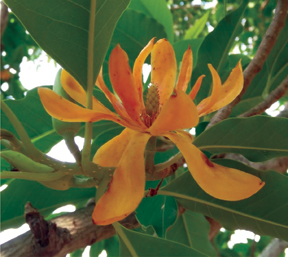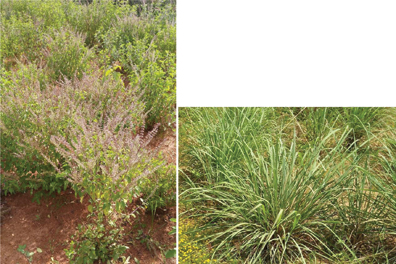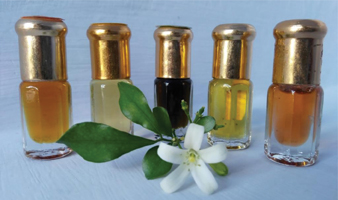V.S. Pragadheesh
Emanating and spreading aroma or volatile chemicals is the oldest way of communication in many living organisms. Aromas or scents from plants provide a lot of information to living organisms through the chemicals present in them. Aroma also plays a major role among animals, for their intraspecific and interspecific communications. In this article, we will discuss the functions and production of various aromas in plants.

What is an aroma?
From a chemistry point of view, an aroma is a bouquet of volatile organic compounds produced by plants, which escape into the atmosphere and diffuse into the air. When an organism with chemical receptors, present in the nose (for most animals) or antennae (in the case of insects), comes into contact with these chemicals, the aroma binds itself to the receptors and sends a signal to the brain, where it is perceived as a smell or aroma.
What type of chemicals are present in an aroma?
Chemical compounds, which are small in size with low molecular weight, are gaseous, or may have the tendency to vapourize fast, produce aroma. Majorly smaller chemicals like isoprene, hexanol, monoterpenoids have the property to vapourize easily and spread an aroma quickly over a short range, whereas organic compounds having up to 15 carbon atoms, such as sesquiterpenoids, diffuse slowly in the air and spread their aroma over a longer range. This is why perfumes are made by blending smaller and larger compounds, which produce instant aroma and also stay for a longer time.

Why do plants produce aroma compounds?
In plants, aroma compounds have various functions. Aroma compounds in flowers attract pollinators like honey bees, butterflies, hoverflies, moths, etc. This way plants transfer their pollen for reproduction. In leaves and stems, these compounds act as defense mechanisms by repelling insects and other plant eating organisms. Even in roots, aroma chemicals play a major role in attracting mutualistic organisms to protect the roots from soil borne pathogens. In many instances, aroma compounds also help plants to become resilient in stressful conditions. Thus, plants produce a variety of aroma compounds which help in their reproduction, defence and also survival in harsh climates.
Additionally, using these chemicals, plants also communicate with each other. When a plant is attacked by an insect, it emits some volatile compounds, which alert nearby plants. Upon receiving this signal, the other plants release their own volatile compounds to repel the insects and defend themselves.

Which types of plants produce aroma compounds?
Although most plants have small amounts of aroma compounds, some plants produce them in higher amounts, which make the plant fragrant; these plants are called aromatic plants. Example: Tulsi, lemongrass, geranium, eucalyptus, rose, jasmine, etc. In general, plants belonging to families Apiaceae (Eg. Corriander), Asteraceae (Eg. Artemisia), Cupressaceae (Eg. Thuja), Geraniaceae (Eg. Geranium), Lamiaceae (Eg. Mint, tulsi, etc.), Lauraceae (Eg. Cinnamomum), Myrtaceae (Eg. Eucaluyptus), Oleaceae (Eg. Jasmine), Poaceae (Eg. Lemongrass, vetiver, etc.), Rosaceae (Eg. Rose), Rutaceae (Eg. Lemon, curry leaves) and Zingiberaceae (Eg. Ginger, turmeric, etc.) are rich in aroma compounds.
Are there trees that produce aroma compounds?
Yes. Trees like eucalyptus produce aroma compounds in leaves, sandalwood trees produce them in the wood, many other trees produce aroma in their flowers.

What are the benefits of growing aromatic plants?
Aromatic plants spread fine aroma wherever they are grown. In some countries, people go on forest walks to smell different aromas emanating from plants to reduce stress and blood pressure. Aromatherapy, healing treatment using aroma chemicals, is gaining much importance in today’s time. Different plant aromas have different effects on the body and mind. For example, lavender has a calming effect, mint keeps one fresh, citrus makes one happy, eucalyptus (and also mint) eases breathing, sandalwood and vetiver have long lasting aroma to keep one fresh, lemongrass helps in concentration, tulsi brings on calmness and clear mind.
How can we retrieve aroma compounds from plants?
Aroma compounds are mostly extracted from plants using the hydro-distillation technique. Essential oils are hydro-distilled fragrant exudates from aromatic plants, which impart smell to the plant. Essential oils comprise a heterogenous group of volatile chemicals with straight-chain, branched-chain, aromatic ring system and exist as various chemical functionalities. Based on the type of plant, essential oils come with different smells and due to the compounds present in them, essential oils also have different colours.
What are the uses of essential oils?
Essential oils have several uses because of the presence of diverse chemicals in them. Essential oils are used in perfumery, cosmetics, food technology, confectionary, personal care products, pharmaceuticals, phytomedicine, aromatherapy, etc. The products we use for our day-to-day activities impart smell because of the presence of essential oils or their components.
What are the different types of aroma that come from plants and which chemicals give out these aromas?
| S. No | Aroma Note | Plants | Common Name | Major Volatile Organic Chemicals |
| Cinnamomumcamphora, Ocimumkilimandscharicum | Camphor tree Camphor basil | Camphor | ||
| Rosmarinus officinalis | Rosemary | Camphor and 1,8-cineole | ||
| 1 | Camphorous | Eucalyptus globulus | Eucalyptus | 1,8-cineole |
| Marjoram hortensis | Marjoram | Cis-sabinene hydrate, trans-sabinene hydrate | ||
| Thujaoccidentalis | Thuja | α-Pinene | ||
| 2 | Green leaf | Grasses | Grasses | Cis-3-hexenyl acetate |
| 3 | Fruity | Artemisia pallens | Davana | Davanone |
| 4 | Jasminy | Jasminumsambac, Jasminum grandiflorum, Nyctanthesarbor-tristis | Jasmine | Benzyl acetate (E, E)-α-farnesene |
| 5 | Lavendery | Lavandulaofficinalis | Lavender | Linalool |
| Citrus limon | Lemon | Limonene, linalool | ||
| Mentha citrata | Bergamot mint | Linalool | ||
| 6 | Lemony | Cymbopogon flexosus | Lemongrass | Neral, Geranial |
| Cymbopogon winterianus | Citronella | Geraniol, citronellal | ||
| 7 | Minty | Menthaarvensis, Menthapiperita | Mints | Menthol |
| Pelargonium graveolens (herbaceous) | Geranium | Geraniol, citronellol | ||
| 8 | Rosy | Rosa damscena | Rose | Citronellol, phenylethanol |
| Cymbopogon martinii | Palmarosa | Geraniol | ||
| Cinnamomum species | Bay leaves | Eugenol | ||
| 9 | Spicy | Pimentaracemosa | All spice | Eugenol |
| Ocimumbasilicum | Basil (Tulsi) | Linalool, methylchavicol | ||
| 10 | Wood earthy | Vetiveria zizanoides | Vetiver | α-vetivone, β-vetivone |
| Pogostemon cablin | Patchouli | Patchouli alcohol | ||
| 11 | Woody | Santalum album | Sandalwood | α-Santalol, β-Santalol |
Activities
- Collect some leaves of tulsi (Ocimum sanctum) and smell them. Can you correlate the smell with a spice that we use in cooking?
- Collect some fragrant leaves from the garden, smell them. Refer to the table above and guess which compounds could be there in the aroma.
References
- Baldwin IT, Halitschke R, Paschold A, von Dahl CC, Preston CA. 2006. Volatile signaling in Plant-Plant Interactions: “Talking Trees” in the Genomics Era, Science, 311, 812-815.
- Baldwin IT. Plant volatiles, Current Biology, 20 (9), R392.
- Kawakami K, Kawamoto M, Nomura M, Otani H, Nabika T, Gonda T. 2004. Effects of phytoncides on blood pressure under restraint stress in shrsp, Clinical and Experimental Pharmacology and Physiology, 31, S27-S28.
- https://besthomescents.com/list-of-scents-and-their-effects/
- Pragadheesh VS, Bisht D, Chanotiya CS, 2020. Terpenoids from Essential Oils. Kirk‐Othmer Encyclopedia of Chemical Technology, 1-22.
The author is a scientist in CSIR-Central Institute of Medicinal and Aromatic Plants, Research Centre, Bengaluru. He works on the chemistry of plant volatiles and their functions. He can be reached at vspragadheesh@cimap.res.in.
